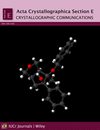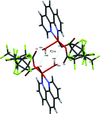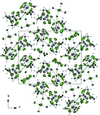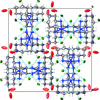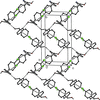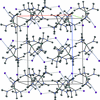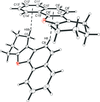issue contents
January 2016 issue

Cover illustration: In connection to the venom Neosurugatoxin (from the edible shellfish, Babylonia Japonica), three variously substituted cyclopenta[c]furans have been characterized. In two structures, crystallography reveals the importance of an intramolecular O-H O hydrogen bond across the bicyclic 5,5-ring system which impacts upon the conformations of the fused five-membered rings. See: Jones, Storey & Harrison [Acta Cryst. (2016). E72, 44-48].
O hydrogen bond across the bicyclic 5,5-ring system which impacts upon the conformations of the fused five-membered rings. See: Jones, Storey & Harrison [Acta Cryst. (2016). E72, 44-48].
editorial
research communications
Download citation


Download citation


The structure of the title salt, {(C5H14N3)[CdCl3]}n, consists of infinite zigzag polyanionic 1∞[CdCl4/2Cl1/1]− chains held together by tetramethylguanidinium cations through N—H⋯Cl hydrogen bonds, leading to a layered structure parallel to (010).
CCDC reference: 1434977
Download citation


Download citation


The molecular structure of a mononuclear CuII complex coordinated by heptafluorobutanoic acid, 1,10-phenanthroline and a water molecule is described.
CCDC reference: 1434356
Download citation


Download citation


The crystal structures of two chromone derivatives are described, one of which has two independent molecules in the asymmetric unit. A comparison of the dihedral angles between the mean planes of the central chromone core with those of the substituents shows that each molecule differs significantly from the others.
Download citation


Download citation


In the cation of the title compound, [Pt2(COD)2F(SbF6)2]SbF6·0.75HF, a fluorine atom bridges two platinum atoms. Each platinum atom is furthermore surrounded by a COD ligand and one fluorine atom of the octahedral SbF6 anion.
CCDC reference: 1439460
Download citation


Download citation


The title complex is one of the few structurally characterized coordination compounds of an organotin(IV) trihalide with 2,2′-biypridine. Its distorted octahedral geometry shows a meridional arrangement of the I atoms and the methyl group is in-plane with the five-membered chelate ring. Directional intermolecular interactions are restricted to weak I⋯H van der Waals contacts.
CCDC reference: 1439787
Download citation


Download citation


In the title coordination polymer, [Co(C3H3O4)Cl(H2O)]n, the sixfold coordination environment of the CoII atom consists of two O atoms from a chelating hydrogen malonate anion (HMal−), one O atom originating from a μ2-bridging malonate ligand (HMal−), one O atom from a water molecule and two μ2-bridging Cl− atoms, connecting neighbouring Co2Cl4 motifs into a two-dimensional polymer extending parallel to (001). Interlayer O—H⋯O hydrogen bonds link the layers into a three-dimensional network.
CCDC reference: 1440440
Download citation


Download citation


The crystal structures of poly[bis(μ2-4,4′-bipyridine N,N′-dioxide-κ2O:O′)trinitratocerium(III)] and its isostructural praseodymium and neodymium analogues feature a 44 grid-like layered structure with interdigitation of layers promoted by C—H⋯O interactions between nitrate anions and 4,4′-bipyridine N,N′-dioxide ligands.
Download citation


Download citation


The cyclohexenone ring in the title compound adopts an envelope conformation and in the crystal, molecules are linked by N—H⋯O and C—H⋯N hydrogen bonds, forming ribbons of edge-fused rings propagating along [010].
CCDC reference: 1440150
Download citation


Download citation


The crystal structures of three complexes of zinc chloride with tri-tert-butylphosphane are reported.
Download citation


Download citation


The low-temperature structure of bis(diethylammonium) tetrachloridocuprate is reported. The complex exhibits thermochromism and has a two-dimensional hydrogen-bonded network through N—H⋯Cl hydrogen bonds.
CCDC reference: 1440683
Download citation


Download citation


The molecular conformations of three highly substituted cyclopenta[c]furans appear to correlate strongly with different intramolecular O—H⋯O and C—H⋯O interactions.
Download citation


Download citation


The first structure with coordinates of tris(trans-1,2-diaminocyclohexane)cobalt(III) chloride monohydrate in the space group I 2d is reported.
2d is reported.
CCDC reference: 1441534
Download citation


Download citation


The title 1:1 co-crystal, butylparaben–isonicotinamide [BPIN, butyl 4-hydroxybenzoate isonicotinamide (1/1)], crystallizes with one molecule each of butylparaben and isonicotinamide. In the crystal, various BPN and ISN molecules are linked via O—H⋯N, N—H⋯O and N—H⋯O=C hydrogen bonds, creating a layered structure.
CCDC reference: 1440986
Download citation


Download citation


The inorganic part of the crystal structure of the 1-D hybrid compound (C4N2H12)2[PbI5]I·H2O contains corner-sharing [PbI6]4− octahedra running as zigzag chains along the a axis. The organic (piprazineH2)2+ cations are lodged around the anionic framework. Water molecules and isolated iodine ions play an important role in the structure connectivity.
CCDC reference: 1429047
Download citation


Download citation


The molecular and crystal structure of N-{4-[(6-chloropyridin-3-yl)methoxy]phenyl}-2,6-difluorobenzamide is reported. The crystal packing is stabilized by N—H⋯N, C—H⋯O, C—H⋯F and C—H⋯π hydrogen bonds supplemented by offset π–π stacking interactions.
CCDC reference: 1441555
Download citation


Download citation


K0.7[FeII3.7FeIII1.3(HPO3)6]·5H2O was synthesized under mild hydrothermal conditions. The open-framework phosphite contains channels extending along [001] in which disordered potassium cations and water molecules are located.
CCDC reference: 1442401
Download citation


Download citation


The title cobalt(II) complex consists of a CoCl2 moiety linked to the terminal N atoms of two dimethyl N-cyanodithioiminocarbonate molecules which leads to an overall distorted tetrahedral configuration around the CoII atom. Weak C—H⋯Cl and C—H⋯S hydrogen-bonding interactions consolidate the packing of the structure.
CCDC reference: 1440755
Download citation


Download citation


A combination of O—H⋯N hydrogen bonds and C—Cl⋯π(pyridyl) interactions links the molecules of the title compounds into (100) sheets.
CCDC reference: 1440028
Download citation


Download citation


The crystal structure of tris(dimethylamido)bis(dimethylamine) zirconium(IV) iodide is reported.
CCDC reference: 1037746
Download citation


Download citation


The components of the 2:1 co-crystal are linked by hydroxy-O—H⋯N(pyridyl) hydrogen bonds into a three-molecule aggregate having the shape of the letter Z. These are connected into a supramolecular ladder by tight amide-N—H⋯O(nitro) hydrogen bonds.
CCDC reference: 1442547
Download citation


Download citation


The asymmetric unit of the title compound contains two crystallographically unique copper complexes. In each complex, the Cu atom is bound to two chloride ligands and to three N atoms of the 2-(4-trifluoromethylbenzylideneamino)ethylamine-bis(2–2aminoethyl)amine ligand to give a distorted square-based pyramidal geometry in which the axial Cu—Cl bond is elongated, indicative of Jahn–Teller distortion. A Cu atom from a symmetry-related molecule is in nearby proximity to the remaining axial Cu site, thus the overall geometry about each Cu atom could be described as being between distorted square-based pyramidal and very elongated Jahn–Teller-distorted octahedral.
CCDC reference: 1442779
Download citation


Download citation


The crystal structure of catena-[(μ3-formato)(μ4-oxalato)terbium(III)] features a three-dimensional 12-connected fcu topology with point symbol (324.436.56), exhibiting thermal stability up to 623 K and strong green photoluminescence in the solid state at room temperature.
CCDC reference: 1436132
Download citation


Download citation


The molecular structure of 3-ferrocenyl-N-phenylpyrrole, [Fe(η5-C5H4cC4H3NPh)(η5-C5H5)] has an L-type shape, with the N-phenylpyrrole moiety fused with the cyclapentadienyl ring being approximately coplanar.
CCDC reference: 1442943
Download citation


Download citation


The Mn2+ ion in [Mn(bdc)(Hspar)2(H2O)0.25]·2H2O (Hspar = sparfloxacin and bdc = benzene-1,4-dicarboxylate) is coordinated by two O,O′-bidentate Hspar neutral molecules (which exist as zwitterions) and an O,O′-bidentate bdc dianion to generate a distorted MnO6 trigonal prism. In [Cu(Hspar)2](bdc)·2H2O,the Cu2+ ion lies on a crystallographic inversion centre and a CuO4 square-planar geometry arises from its coordination by two O,O′-bidentate Hspar molecules. The bdc dianion acts as a counter-ion to the cationic complex and does not bond to the metal ion.
Download citation


Download citation


The crystal packing of the FeII porphyrin derivative results in channels parallel to [010] where the n-hexane solvent molecules are located. UV–vis data of a CHCl3 solution and the solid of the title compound are also reported.
CCDC reference: 1442707
Download citation


Download citation


The reaction of 1-naphthol with cyclohexadiene in the presence of catalytic amounts of Lewis acid, which interacts with 1-naphthol with release of protons, does not afford the Diels–Alder adduct but the Friedel–Crafts products followed by aromatization. The crystal structure of the final tetrahydrobenzonaphthofuran product is described.
CCDC reference: 1429774


 journal menu
journal menu








